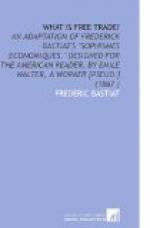Now, among these obstacles, there is one which we ourselves have lately placed, and that at no little expense, between Montreal and New York. This consists of men planted along the frontier, armed to the teeth, whose business it is to place difficulties in the way of the transportation of goods from one country to another. These men are called custom-house officers, and their effect is precisely similar to that of rutted and boggy roads. They retard and put obstacles in the way of transportation, thus contributing to the difference which we have remarked between the price of production and that of consumption; to diminish which difference, as much as possible, is the problem which we are seeking to resolve.
Here, then, we have found its solution. Let our tariff be diminished: we will thus have constructed a Northern railway which will cost us nothing. Nay, more, we will be saved great expenses, and will begin, from the first day, to save capital.
Really, I cannot but ask myself, in surprise, how our brains could have admitted so whimsical a piece of folly as to induce us to pay many millions to destroy the natural obstacles interposed between the United States and other nations, only at the same time to pay so many millions more in order to replace them by artificial obstacles, which have exactly the same effect; so that the obstacle removed and the obstacle created, neutralize each other, things go on as before, and the only result of our trouble is a double expense.
An article of Canadian production is worth, at Montreal, twenty dollars, and, from the expenses of transportation, thirty dollars at New York. A similar article of New York manufacture costs forty dollars. What is our course under these circumstances?
First, we impose a duty of at least ten dollars on the Canadian article, so as to raise its price to a level with that of the New York one—the government, withal, paying numerous officials to attend to the levying of this duty. The article thus pays ten dollars for transportation, and ten for the tax.
This done, we say to ourselves: Transportation between Montreal and New York is very dear; let us spend two or three millions in railways, and we will reduce it one-half. Evidently the result of such a course will be to get the Canadian article at New York for thirty-five dollars, viz.:
20 dollars—price at Montreal.
10 " duty.
5 " transportation
by railway.
—
35 dollars—total, or
market price at New York.
Could we not have attained the same end by lowering the tariff to five dollars? We would then have—
20 dollars—price at Montreal.
5 " duty.
10 " transportation on the
common road.
—
35 dollars—total, or
market price at New York.
And this arrangement would have saved us the $2,000,000 spent upon the railway, besides the expense saved in custom-house surveillance, which would of course diminish in proportion as the temptation to smuggling would become less.




